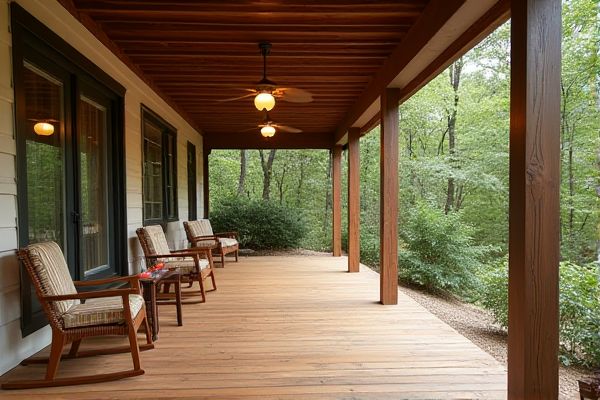
Wood porches offer a traditional appearance and natural warmth but require regular maintenance to prevent rotting, warping, and insect damage. Composite porches provide low maintenance, durability, and resistance to weathering while mimicking wood's aesthetic, making them a practical choice for Your home; explore this guide to determine which porch material best suits Your lifestyle and budget.
Table of Comparison
| Feature | Wood Porch | Composite Porch |
|---|---|---|
| Material | Natural wood (cedar, pine, redwood) | Blend of wood fibers and plastic |
| Durability | Moderate; prone to rot, insect damage | High; resistant to rot, insects, and fading |
| Maintenance | Requires regular staining/sealing | Low maintenance; occasional cleaning |
| Cost | Lower initial cost | Higher upfront investment |
| Appearance | Natural, authentic wood grain | Consistent look; mimics wood |
| Longevity | 10-15 years with maintenance | 25+ years lifespan |
| Environmental Impact | Renewable resource; biodegradable | Recycled materials; less biodegradable |
| Installation | Standard carpentry skills needed | Similar installation; may require special fasteners |
Introduction: Choosing Between Wood and Composite Porches
Wood porches offer natural beauty and classic charm with a variety of grain patterns and warm tones, but require regular maintenance such as sealing and staining to withstand weather conditions. Composite porches provide durability and low upkeep by combining wood fibers and plastic, resisting rot, insects, and fading while maintaining a wood-like appearance. Your decision depends on balancing the authentic aesthetics of wood with the long-lasting, hassle-free benefits of composite materials.
Material Overview: What Is Wood? What Is Composite?
Wood porches are constructed from natural timber, offering authentic grain patterns and warmth but requiring regular maintenance to prevent rot, insect damage, and weathering. Composite porches are made from a blend of wood fibers and recycled plastic, providing enhanced durability, resistance to moisture, and minimal upkeep while mimicking the appearance of natural wood. Choosing between wood and composite materials depends on factors such as budget, desired aesthetic, and long-term maintenance preferences.
Aesthetics and Design Versatility
Wood porches offer natural warmth and timeless beauty with unique grain patterns and rich color variations that enhance curb appeal. Composite porches provide greater design versatility through a wide range of colors and textures that mimic real wood while resisting fading and staining. Both options allow customization, but composite materials enable low-maintenance styles accommodating modern architectural trends.
Durability and Lifespan Comparison
Wood porches offer natural beauty but are prone to rot, insect damage, and require regular maintenance, with a typical lifespan of 10 to 15 years. Composite porches combine wood fibers and plastic, providing superior resistance to moisture, fading, and pests, often lasting 25 to 30 years or more with minimal upkeep. Homeowners seeking long-term durability and reduced maintenance costs typically prefer composite materials for porch construction.
Maintenance Requirements and Effort
Wood porches require regular maintenance such as sealing, staining, and sanding to prevent rot, insect damage, and weathering, demanding significant time and effort. Composite porches offer low-maintenance benefits, resisting fading, splintering, and mold growth while only needing occasional cleaning with soap and water to maintain their appearance. Choosing a composite porch reduces your maintenance workload and extends the longevity of your outdoor space.
Cost Analysis: Upfront and Long-Term Investment
Wood porches typically have a lower upfront cost but require regular maintenance such as staining and sealing, which can increase long-term expenses. Composite porches demand a higher initial investment but offer durability and low maintenance, reducing costs related to repairs and upkeep over time. You should weigh the immediate budget against potential future savings when deciding between wood and composite materials for your porch.
Environmental Impact and Sustainability
Wood porches offer natural biodegradability and lower carbon footprints when sourced from sustainably managed forests, supporting ecosystem conservation. Composite porches, made from recycled plastics and wood fibers, reduce landfill waste and demand less frequent replacement, enhancing long-term sustainability. Lifecycle analysis shows composite materials often require less maintenance and preserve resources, but wood remains preferable for full recyclability and minimal chemical processing.
Weather Resistance and Performance
Composite porches offer superior weather resistance compared to wood porches due to their synthetic materials, which resist moisture, rot, and insect damage effectively. Wood porches require regular sealing and maintenance to prevent warping, cracking, and decay under varying weather conditions. Over time, composite porches maintain structural integrity and appearance better, making them a durable choice for climates with heavy rain or fluctuating temperatures.
Safety and Comfort Considerations
Wood porches offer natural warmth and grip, enhancing safety by reducing the risk of slips, especially when wet or icy, but they require regular maintenance to prevent splinters and decay. Composite porches provide consistent traction with innovative, slip-resistant surfaces and resist moisture, mold, and pests, improving overall comfort and reducing maintenance concerns. Your choice between wood and composite should factor in the balance between natural feel and long-term safety features tailored to your environment.
Final Verdict: Which Porch Material Is Best for You?
Choosing between wood and composite porch materials depends on your priorities for maintenance, durability, and aesthetic appeal. Wood offers natural beauty and a traditional look but requires regular upkeep to prevent rot, warping, and insect damage, whereas composite porches provide low maintenance, resistance to weather and pests, and long-lasting color retention. Your best choice hinges on whether you value the authenticity and warmth of wood or prefer the convenience and resilience of composite materials.
 homyna.com
homyna.com